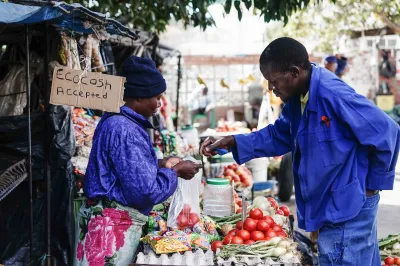Consumer Lending and Financial Inclusion in Latin America
The economic success of many Latin American countries and the rise out of poverty of millions of households in recent years has led to a strong growth in consumer lending in low and middle-class segments. This is a development we have highlighted previously on this blog as a trend worth monitoring.
The types of providers and products that can be considered “consumer lending” have evolved in different ways across markets within the region. At the same time, certain common features have emerged, such as the growing role of retail chains, challenges and opportunities for risk assessment of consumers that often lack significant formal financial footprints, and inconsistent sharing of credit history across different provider segments. These are issues that will impact the growth and sustainability of this sector, but given the diverse nature of the market, are not always going to be solved by industry action alone. So there is a clear and important need for policy makers to act.
 Women count money
Women count money
Photo Credit: Ariel Slaton
Policy makers in the region have identified important risks resulting from this market evolution, and have taken some important actions in areas such as portfolio quality, provisioning requirements, consumer protection norms in areas such as product suitability, and household level surveys to better understand the demand-side drivers—and consequences—of consumer credit growth at the base of the pyramid.
However, there is no clear consensus in the region on how to measure and assess market penetration, how to separate the benefits from the disadvantages, or how regulators should proactively control or reactively respond to the market.
On March 12 and 13, of this year, CGAP, the Interamerican Development Bank’s Multilateral Investment Fund (MIF), and the Association of Bank Supervisors of the Americas (ASBA) hosted a discussion with regulators in Latin America on consumer lending in the region. This meeting was an important step towards building regional consensus and sharing successful policy approaches from one market to another. Out of these discussions, participants identified several key areas where there is a need for more knowledge exchange and subsequent action to support responsible expansion of consumer lending:
Expand the scope of regulation in order to bring the provision of credit – across all population segments and provider types - under the financial sector authority’s purview.. Most Latin American markets don't regulate many credit-only institutions since they do not intermediate people's savings and therefore are not considered subject to prudential regulation. Chile estimates that nearly half of consumer credit in the market comes from unregulated institutions, while Brazil estimates this to be around 30% and Mexico 20%. Solving the coverage problem should help regulators achieve a full view of the market and assess changes in the offering and use of credit that might entail risks, and avoid the regulatory arbitrage that currently exists in many of these markets.
Regulate use of credit bureaus to ensure a more complete and shared view of credit risk at the household level. This can be achieved by promoting broader inclusion of institutions in the bureaus and making information sharing across providers and bureaus mandatory. There are open questions around whether bureaus should be public or private, whether one or more should exist, and whether the governance aspects and pricing are appropriate. But the consensus is that providers in general should assess risk based on consultation to credit bureaus.
Identify the data models needed to track healthy lending development. One of the common challenges heard from policymakers in the region is “we don’t have the full market picture nor the data to understand all the actors providing consumer credit.” Improving the breadth and quality of information on consumer credit in a market should help identify what providers are offering what kind of products, to what consumer segments, and the performance and health of their consumer credit portfolios.
Expand understanding of best practices in regulating consumer lending. Different countries have exercised different approaches to controlling consumer credit expansion and monitoring individual providers’ portfolios and lending practices, with many successful cases across the region. It would therefore be useful to have a shared understanding of what rules, policies, and market monitoring tools work best in regulating consumer lending.
Understand how consumer and behavioral insights might change existing consumer protection guidelines and norms by unlocking how consumers think about consumer credit, and what leads some consumers to manage their debt responsibly while others end up in over their heads. Consumer protection has been a foremost priority in many markets, but the traditional views on transparency as the key ingredient for sound choices in lending products are changing, since other factors seem to drive consumer behavior besides pure cost of credit and ability to compare offers.
Down the road, as business models evolve, learn more about how innovations in branchless banking may expand access to credit and promote an early assessment of how this might change existing risks or bring new ones. The interest in advancing financial inclusion is driving reforms that allow new non-bank players to take on roles along the financial services value chain. As a result, many mobile banking initiatives of different sorts are being launched in most markets, in most cases around mobile payments and mobile accounts. The international experience shows that it is likely that these business models eventually expand into credit, and so policymakers need to understand these new models now while they are in their initial stage of development.
Of course these issues cannot be resolved all at once, and will require a great degree of political will on the part of policymakers. At the same time, recent policy innovations across the region make it clear that our starting point follows significant experience across markets and needs to be consolidated and standardized as possible. This is the next step for groups such as those we met with in March. One thing is certain though, this market is only going to keep growing and increasing in diversity, so regulators can no longer focus solely on the limited range of providers within their authority if they want to ensure stability and responsible financial inclusion.
Rudy Araujo is the Secretary General of the Association of Bank Supervisors of the Americas (ASBA).
Sergio Navajas is a senior specialist at the Inter-American Development Bank’s Multilateral Investment Fund, where he leads projects and research on microfinance.
Rafe Mazer and Xavier Faz are part of the Latin America regional team at CGAP.




Add new comment